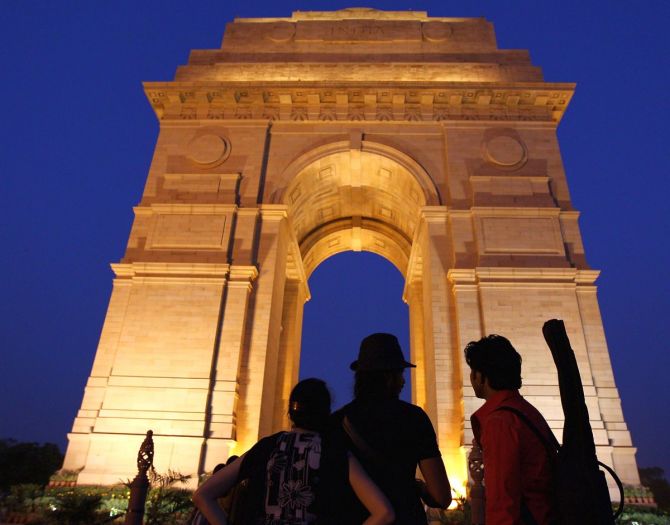 | « Back to article | Print this article |
Here's one for history buffs. After whom is Delhi's iconic shopping centre Connaught Place named? Prince Arthur, the Duke of Connaught. That was easy. Here's a tough one. Who set the ball rolling for the construction of India Gate? Duke of Connaught again.

He laid the foundation stone of the All India War Memorial Arch in Delhi, or India Gate as it is now known, exactly 100 years ago on February 10 in 1921 during a visit to the country.
The 42-metre-high sandstone monument, sometimes compared to the Arc de Triomphe in Paris, was opened after a decade. Ninety years on, it is still the centre of India's sprawling capital, an eternal flame burning under the arch in memory of soldiers who laid down their lives for the country.
Prince Arthur, Duke of Connaught and Strathearn, was an uncle of King George V, the then reigning monarch of the British Empire who held a grand durbar in Delhi in 1911, where he also announced the shifting of the imperial capital from Calcutta to Delhi.
Following this decision, work began to create a new capital in the Raisina Hill area, the foundation stone of which was laid by the king on December 15, 1911.
Sir Edwin Lutyens and Sir Herbert Baker laid out their plans for a new imperial capital, with the Viceroy's House (now Rashtrapati Bhavan) and the North Block and South Block as the centrepiece of New Delhi, as the city was officially named in 1926.
However, during the construction of the new imperial capital city, World War I broke out and a large number of soldiers from the British Indian Army were sent to war zones.
In 1921, during the Delhi leg of his India visit, the Duke of Connaught laid the foundation of the All India War Memorial on February 10 and the Council Chamber of the Parliament House, designed by Baker, two days later.
According to a 1921 publication of the Superintendent Government Printing, Calcutta, units of the Army from across the country gathered at the event in "New Delhi", which was under construction.
"On this spot, in the central vista of the capital of India, there will stand a Memorial Archway, designed to keep present in the thoughts of the generations that follow after, the glorious sacrifice of the officers and men of the Indian Army who fought and fell in the Great War," the Duke of Connaught said in his speech.
"The men were nobly led and the officers were bravely followed, and we give thanks to Almighty Providence that the cause for which they fought was the cause which prevailed, and that our memorial is not one of lives lost in vain, but a monument of great and overwhelming victory," he said.
The All India War Memorial Arch was built to honour the soldiers who died in the First World War (1914-1918) and the Third Anglo-Afghan War (1919).
Look closely, and you can see the names of soldiers who died etched on its surface.
Over 80,000 Indians laid their lives in those campaigns and India Gate has the names of 13,516 soldiers.
The Amar Jawan Jyoti was built to commemorate India's victory in the India-Pakistan War of 1971, an Army official had said.
The Amar Jawan Jyoti is a memorial symbolised by an inverted bayonet and a soldier's helmet over it with an eternal flame burning beside it. It was built in 1972 underneath the India Gate arch in memory of the soldiers who lost their lives.
The India Gate lawns are still the place for people in the city to go for a walk, picnic or just pick up an ice-cream and a must-see for every visitor to the city. A continuum in history as the city has grown over the decades.